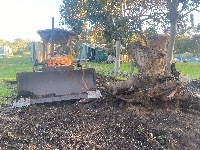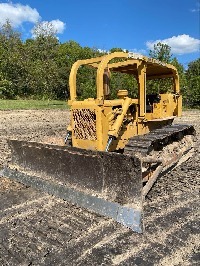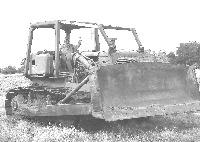- Posts: 2120
- Thank you received: 787

ACMOC Membership Benefits
- FREE quarterly magazine filled with content about antique Caterpillar machines
- FREE classified listings
- ACMOC store discounts and specials
- Full Bulletin Board Access
- Marketplace (For Sale/Wanted)
- Technical Library
- Post attachments
$44 /year ELECTRONIC
$60 /year USA
$77 /year International
Compatibility with '60 Cat D6b
- trainzkid88
-

- Offline
- Platinum Boarder
- Member
Please Log in or Create an account to join the conversation.
Angle blade refers to changing the blade in relation to the tractor to direct the material one side or the other depending on the angle direction.
A straight blade is usually fixed and cannot be angled. Some can be tilted,.some can't Straight blades have less linkages to wear out and are usually heavier duty. Straight blades do not have a "C" frame.
Most blades will have a curvature in them to roll the material so the machine can push more material..
944A - Machine SN 43A2589 Engine SN 90A284
955K- Machine SN 71J3772 Engine SN 83Z0704
D6 SN's 4R732sp, 5R2724, 5R4832
D8 SN's 15A1254, 15A2287, 15A2723
Please Log in or Create an account to join the conversation.
Please Log in or Create an account to join the conversation.
- Deas Plant.
-

- Offline
- Platinum Boarder
- User
- Posts: 6637
- Thank you received: 928
A li'l bitta history - the VERY early dozer blades were simply flat plates mounted in front of the tractor. It didn't take long at all for some smart people to 'figger' out that a vertical curve in the blade face would help it to both dig better and carry more material. It didn't take the less smart people long to catch on and copy the smarter ones.
ALL the early dozer blades were fixed straight across the front of the tractor. I suspect that some bright spark watched an angled blade on a pull grader at work and 'figgered' out that it might be a good idea to have a similar arrangement in a dozer blade and so invented the angling dozer blade like yours.
About the same time, give or take, somebody had the bright idea that it might be useful to be able to TILT the blade lower on one side to make it easier to cut ditches or pioneer roads on hill sides and invented the tilt brace to achieve this desired result.. Tilt braces also served another purpose in that, IF you had them on BOTH sides fo the blade, you could tip the blade forward for better digging or back for better carrying capacity.
Whether angled or straight, an angling blade can be titled to one side or the other by adjusting tilt braces. If the blade linkages have little wear, it will need both braces adjusted in opposite directions to get much tilt. If the linkages are worn, you can get some reasonable/workable tilt by adjusting one brace only but that places more load on one brace than the other.
On a STRAIGHT blade like seiscat's, you only need to adjust one brace to TILT the blade but BOTH braces in the same direction to tip the blade forward or back to adjust the angle of the cutting edge for better cutting or to roll the blade back for better carrying capacity. Angle blades do not have much scope for tipping the blade back or forward when new due to having the fixed center angling pivot pin but usually 'gain' some scope for that as they wear. The FIRST bulldozer:
To clarify, "Cutting angle" is usually a reference to the 'tip' forward or back of the blade face. 'Tilt' usually refers to having one side of the blade lower or higher than the other. "Angle" usually refers to the blade being angled across the line of travel to drift the material to one side or the other.
A 2-way blade, a VERY rare beast these days, would only have up-n-down adjustment. A 4-way blade has up-n-down and side-to-side TILT adjustment. A 6-way blade has up-n-down, tilt and angle adjustment - - - NONE of which are available on the image above.
The above 'ranting' should make it about as clear as mud for you.
Although a little more 'long-winded', I hope this makes things a little more clear for you than trainzkid88's earlier post.
Just my 0.02.
You have a wonderful day. Best wishes. Deas Plant.
Attachments:
Please Log in or Create an account to join the conversation.
- trainzkid88
-

- Offline
- Platinum Boarder
- Member
- Posts: 2120
- Thank you received: 787
Please Log in or Create an account to join the conversation.
- Deas Plant.
-

- Offline
- Platinum Boarder
- User
- Posts: 6637
- Thank you received: 928
Sounds like you have 6-way blade with powered raise and lower and the angle and tilt functions being manual - not uncommon with earlier blades.
If you post a couple of photos of your blade, I suspect that some people on this BB will manage to ID it for you.
Just my 0.02.
You have a wonderful day. Best wishes. Deas Plant.
Please Log in or Create an account to join the conversation.
Leverage... it's what's for dinner!
'60 CAT D6b w/11.5' blade
JD 350b loader
'68 Case CK580 x 2 loader/backhoe
'02 JD 260 Skid Steer
Many other assorted heavy equipment toys.
Please Log in or Create an account to join the conversation.
- Deas Plant.
-

- Offline
- Platinum Boarder
- User
- Posts: 6637
- Thank you received: 928
If you're gonna build a brush guard to stop 'stuff' coming over the top of the blade, it is a good idea to have it raked forward at about the same angle as the top of the blade moldboard and 'tissue' paper is NOT a recommended construction material. It is also not a bad idea to have the middle section in front of the radiator sold plated - I'm gonna leave you to 'figger' out why. LOL.
Just my 0.02.
You have a wonderful day. Best wishes. Deas Plant.
Please Log in or Create an account to join the conversation.
- trainzkid88
-

- Offline
- Platinum Boarder
- Member
- Posts: 2120
- Thank you received: 787
yes we covered the upper half with woven wire-mesh that cam from a gravel screening plant that was made with 3/16 wire woven into 3/4 grid pattern that stopped a lot of sticks and debris we also welded some bits of medium tensile round bar onto the tynes to stop it digging so much and they acted as a foot and wear bar
Please Log in or Create an account to join the conversation.
Attachments:
Please Log in or Create an account to join the conversation.
ACMOC
Antique Caterpillar Machinery Owners Club
1115 Madison St NE # 1117
Salem, OR 97301
support@acmoc.org
"I became a member recently because the wealth of knowledge here is priceless."
- Chris R
"I also joined a year ago. had been on here a couple of times as a non-member and found the info very helpful so I got a one year subscription (not very expensive at all) to try it out. I really like all the resources on here so I just got a three year. I think its a very small price for what you can get out of this site."
- Jason N




